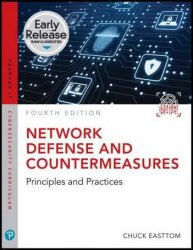 Название: Network Defense and Countermeasures: Principles and Practices, 4th Edition (Early Access) Название: Network Defense and Countermeasures: Principles and Practices, 4th Edition (Early Access)
Автор: Chuck Easttom
Издательство: Pearson Education
Год: 2024
Страниц: 640
Язык: английский
Формат: epub
Размер: 15.3 MB
All you need to know about defending networks, in one book.
Clearly explains concepts, terminology, challenges, tools, and skills Covers key security standards and models for business and government The perfect introduction for all network/computer security professionals and students
Welcome to today’s most useful and practical introduction to defending modern networks. Drawing on decades of experience, Chuck Easttom brings together updated coverage of all the concepts, terminology, techniques, and solutions you’ll need to be effective.
Easttom thoroughly introduces the core technologies of modern network security, including firewalls, intrusion-detection systems, and VPNs. Next, he shows how encryption can be used to safeguard data as it moves across networks.
You’ll learn how to harden operating systems, defend against malware and network attacks, establish robust security policies, and assess network security using industry-leading standards and models. You’ll also find thorough coverage of key issues such as physical security, forensics, and cyberterrorism.
Throughout, Easttom blends theory and application, helping you understand both what to do and why. In every chapter, quizzes, exercises, projects, and web resources deepen your understanding and help you use what you’ve learne--in the classroom and in your career.
The hottest topic in the IT industry today is computer security. The news is replete with stories of hacking, viruses, and identity theft. The cornerstone of security is defending the organizational network. Network Defense and Countermeasures: Principles and Practices offers a comprehensive overview of network defense. It introduces students to network security threats and methods for defending the network. Three entire chapters are devoted to firewalls and intrusion-detection systems. There is also a chapter providing a basic introduction to encryption. Combining information on the threats to networks, the devices and technologies used to ensure security, as well as concepts such as encryption provides students with a solid, broad-based approach to network defense.
This book provides a blend of theoretical foundations and practical applications. Each chapter ends with multiple choice questions and exercises, and most chapters also have projects. Students who successfully complete this textbook, including the end of chapter material, should have a solid understanding of network security. Throughout the book the student is directed to additional resources that can augment the material presented in the chapter.
Learn How To:
Evaluate key network risks and dangers
Choose the right network security approach for your organization
Anticipate and counter widespread network attacks, including those based on “social engineering”
Successfully deploy and apply firewalls and intrusion detection systems
Secure network communication with virtual private networks
Protect data with cryptographic public/private key systems, digital signatures, and certificates
Defend against malware, including ransomware, Trojan horses, and spyware
Harden operating systems and keep their security up to date
Define and implement security policies that reduce risk
Explore leading security standards and models, including ISO and NIST standards
Prepare for an investigation if your network has been attacked
Understand the growing risks of espionage and cyberterrorism
Audience:
This book is designed primarily as a textbook for students who have a basic understanding of how networks operate, including basic terminology, protocols, and devices. Students do not need to have an extensive math background or more than introductory computer courses.
Contents:
Chapter 1. Introduction to Network Security
Chapter 2. Types of Attacks
Chapter 3. Fundamentals of Firewalls
Chapter 4. Firewall Practical Applications
Chapter 5. Intrusion-Detection Systems
Chapter 6. Encryption Fundamentals
Chapter 7. Virtual Private Networks
Chapter 8. Operating System Hardening
Chapter 9. Defending Against Virus Attacks
Chapter 10. Defending against Trojan Horses and Phishing
Chapter 11. Security Policies
Chapter 12. Assessing System Security
Chapter 13. Security Standards
Chapter 14. Physical Security and Disaster Recovery
Chapter 15. Techniques Used by Attackers
Chapter 16. Introduction to Forensics
Chapter 17. Cyber Warfare and Terrorism
Appendix A. Answers
Glossary
Скачать Network Defense and Countermeasures: Principles and Practices, 4th Edition (Early Access)
|